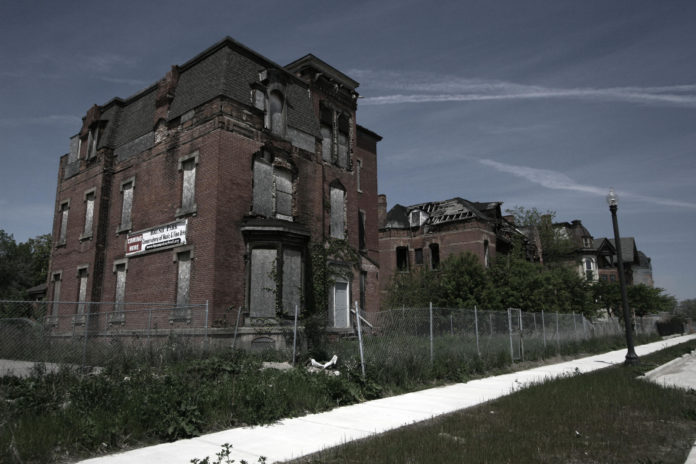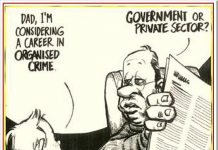I met a 29 year-old firefighter from Highland Park, MI, yesterday. Highland Park is completely surrounded by Detroit, and at one time had two large automotive plants (Ford and Chrysler). Chrysler’s headquarters were located in Highland Park for 70 years. At it’s peak, Highland Park had a population of around 50,000, but as of today less than 11,000 people call Highland Park home.
Detroit is often considered a failed city within Michigan. Highland Park is often considered the Detroit of Detroit.
This young man described himself as a millennial, and a Democratic Socialist. He also described himself as a Constitutionalist, though in our conversation he seemed to have a very limited understanding of what the Constitution says. Basically, he sees the Constitution as a framework whereby societal ills are solved and everyone is made equal in every conceivable way. What the Constitution says did not seem important to this young man. He read it as a ‘living document’ to interpret based on what it should say, and what he thought it should say is basically the opposite of what it actually says. His definition of a ‘Constitutionalist’ is someone who completely ignores the Constitution.
I want to stress that this was a very nice young man. He was somewhat passionate and at times animated, but he was also kind and respectful of others. He shared with me that as a full-time firefighter in Highland Park, he makes only $11 an hour. I told him that the McDonalds around the corner paid more. He wanted to know how it is that firefighters in cities around Detroit (suburbia) make more than firefighters in Detroit, when there are far more dangerous fires in Detroit (and Highland Park), making the job far more dangerous in Detroit. I decided to answer his question. How much of this he took in, I do not know, but I thought the answer was illustrative, so I wanted to share it here.
Detroit, like Highland Park, peaked in the 1950s, when Detroit was the the fifth largest city in the United States, with a population of just under two million people. Detroit began an unbroken string of Democratic-only mayors starting on January 2, 1962, that continues to this day. Democrats have had complete control over the city of Detroit ever since, and as of today, Detroit has a population of about 670,000.
Cities are incorporated in such a way that the people living within the city limits vote for the city leadership, and in which the city’s ability to tax is limited to the people living within the city limits. In this way, the City of Detroit taxes Detroit to pay Detroit’s bills, the City of Highland Park taxes the people within Highland Park to pay Highland Park’s bills, and the people of Grand Rapids (on the other side of Michigan) tax the people of Grand Rapids to pay Grand Rapids’ bills. Firefighting being a city-led government function, paying firefighters is one of those bills.
Cities do sometimes make agreements to share resources, and I, frankly, don’t know why Highland Park has its own fire department, rather than reaching an agreement to use Detroit’s fire department, but then I don’t live in either Highland Park or Detroit, so I have no say in such decisions.
The median family income in Highland Park is $26,484, whereas in Detroit it is $36,842. The median family income in Michigan is $72,036. What is crazy about these numbers is that in their peak, Detroit and Highland Park were thriving hubs of commerce, with the highest wages in the world.
I don’t think it takes a rocket-scientist to understand that a city of two million people with the highest incomes in the world can raise much more in tax revenues than can a city of 670,000 making half the state median. What a lot of people don’t seem to understand is that a city of two million with the highest incomes in the world can raise a whole lot more money than can a much smaller and poorer city, even if the thriving city has much lower tax rates.
People love to confuse tax revenues and tax rates, but the truth is that tax revenues and tax rates often move in opposite directions. When we have lower tax rates, people not only get to keep more of what they earn, but also our economy grows faster, leading to more higher paying jobs. In other words, more money gets taxed. When we increase tax rates, it can stifle economic growth, leading to less money getting taxed. 20% of $1,000 and 40% of $500 both equal $200, so obviously rates and revenues are separate things.
People will sometimes argue that government spending has a multiplier effect. Cool. But then so does private spending. Government spending takes money out of private hands (this is true even when the government borrows, as inflation weakens the currency and reduces the buying power of the people). We the people spend money on the things we the people want, whereas the whole point of government spending is to spend money on things we would otherwise not buy. Some of the things government does make the economy more efficient, such as enforcing truth in advertising laws, but the vast majority of the things government does makes our economy less efficient, and as a result, the multiplier effect of government spending is much lower than the multiplier effect of private spending. By taxing the public to spend, the government reduces the multiplier effect, and reduces growth. That leads to a smaller economy than we would otherwise have, over time, and lower tax revenues.
As an illustration of this effect over time, understand that the United States spends less than the world average on national defense (we spend 3.4% vs a world average of 4%), and yet we spend more money (measured in dollars) than the next twelve nations combined, on national defense.
There is an old saying that money is the root of all evil. If that is true, than short-term thinking must come in a close second. Many people look at the economy as a static thing, and will reason that taxing a higher percentage of the economy will give them more money, and in the short term that is sometimes true, but every tax cut in recent memory has increased tax revenues. In the case of George W. Bush, revenues dropped initially and then rebounded. In the case of Kennedy, Reagan, and Trump, revenues increased immediately, even as rates were reduced. Kennedy and Reagan cut tax rates the most, and in both cases revenues doubled. Note that I did not say they grew – I said they doubled.
What is true at the national level is even more true at the city level. What a city can afford to spend will always be a proportion of the city economy. A bigger economy makes more tax revenue possible. The difference between a city and the nation as a whole is that with the nation, it is hard to make the economy shrink (though it is easy to make it stop growing or to grow much more slowly) whereas it is very easy to make a city’s economy shrink. The effects of a shrinking economy tend to be disastrous.
What happened to Detroit (and Highland Park) is that when the last Republican mayor in the history of the city left office, on January 2, 1962, the city’s attitude toward business shifted from one designed to attract businesses (and to encourage them to grow), to one designed to maximize the tax revenues paid by businesses. Corporate taxes became popular, and The Big Three, along other corporations within the city limits, were told to pay their ‘fair share.’ The city also began to take a harder line on how businesses operated and how they treated their employees. The city began assisting unions in negotiating more lucrative contracts, and began to tax ‘the rich’ at prohibitively high rates, in order to give assistance to ‘the poor.’
‘Fair share,’ with regard to taxes, is not a number or a percentage. I have never heard a Democrat tell me what proportion of tax revenues is ‘fair.’ Currently, the rich pay virtually all federal income taxes and half the public pays no federal income taxes at all, and yet we are STILL told that the rich have to pay their ‘fair share’.
There is no ‘fair share’. That phrase is French for ‘more’.
There is nothing wrong with giving assistance to those in need, but how assistance is given is important. At Detroit’s peak, jobs were plentiful, so the easiest way to help someone in need was to assist them in gaining employment. Detroit, however, decided that it was not fair to ask an impoverished person to find a job. Doing so was deemed ‘blaming the victim.’ If there was a father in the home, perhaps you could expect him to work, but if there was not, people were given welfare checks with no expectation of work – they were literally paid not to work.
The incentives welfare put in place would not have destroyed Detroit had it not been for the new attitude taken toward businesses, and it is no surprise that The Big Three (and other corporations) began to move to the suburbs where treatment was much more pro-business. The high paying jobs went with them, and the workers making those high paying jobs followed.
The suburbs of Detroit, incidentally, are still thriving, with a combined population of 4.3 million people – roughly half the population of Michigan.
There is a popular myth that ‘white flight’ destroyed Detroit, and certainly it helped, but it is worth noting that ‘white flight’ occurred in the 1970s, which was well after Detroit’s decline began. It is also worth noting that the wealthier black people left Detroit too, making ‘white flight’ more accurately called ‘wealth flight.’
What really happened was that declining Detroit saw it’s crime rates rise, and when the race riots of the early 1970s happened, the liberal leadership of Detroit allowed the rioters to lawlessly destroy property, rather than putting the riots down. Peaceful protests are legal and should be encouraged, but the ‘protests’ that turned Detroit into the arson-capitol of the country should have been stopped by the city, and were not. As a general rule, residents do not like crime, and so when Detroit began to ignore crime, those residents who could, left, accelerating Detroit’s decline.
Nor was the decline of Detroit entirely Detroit’s fault. The policies that affected Detroit occurred at the federal and state levels, as well as at the city level. Still, not all cities were affected the way Detroit was, and that is entirely because of the leadership of Detroit, which became increasingly antagonistic toward businesses throughout the 60’s and 70s.
By the 80s, the damage was done. And yes – as crazy as it is, Detroit went from the wealthiest city in the world to a failed, burned-out ruin in just twenty some odd years.
I keep hearing about renaissances in Detroit, and certainly parts of Detroit are doing well. The business district is thriving. Corktown, Greektown, Mexicantown, Palmer Woods, and Indian Village are booming. The River Front is doing well. But Detroit is still a city designed for two million people that has only 670,000 people, and those 670,000 people have, on average, only half the state median income, meaning that there is limited money to tax. I did not mention the public schools, but Detroit has arguably the worst public schools in the country. Half of the children in Detroit go to charter schools, but the state has been trying to shut the charter schools down.
The only way to fix Detroit is to get people to move back into it, and ideally people with money. Families need to decide to live in the city, which won’t happen unless the schools are functional. Ironically, Detroit has the best funded public school system in the state, but costs are artificially inflated by an unwillingness to close schools as population levels continue to decline. The underlying economic situation in Detroit is not improving – and the reason is that the city leadership are continuing with the same policies that led Detroit to decline in the first place (though ANTIFA/BLM riots were not allowed last year – kudos to the Detroit Police Department for keeping things peaceful).
In other words, the reason a 29 year old firefighter with two years’ experience in Highland Park makes only $11 an hour is that Highland Park cannot afford to pay any more than that. Detroit and Highland Park struggle to provide even the most basic of civil services, as they lack the tax base to pay for such things. And that’s not just in firefighting – it’s everywhere.
This also means that the better firefighters (and other municipal workers) will tend to be attracted to places that can afford to pay firefighters more. Highland Park will tend to attract people who want to be firefighters, but who lack the skills and experience to demand decent pay. Unfortunately for this young man, though he sees (and acutely feels) the problem, he sees it as a moral failing rather than an economic reality. He has no sense of cause and effect relationships, and no interest in the kinds of changes that would make Detroit (and Highland Park) improve, such that the wages of firefighters and other municipal workers can rise.
What things would truly improve Detroit? The city needs to reverse it’s outlook on business, acting to attract them rather than to punish them. Detroit needs to partner with a few large corporations to bring in a base of good paying jobs, in parts of the city that are still dead. That would be a start, but it is not enough on its own. Detroit also needs to fix it’s schools, which will be difficult given that the teacher’s union is perfectly happy to have them remain broken. A huge expansion of charter schools (perhaps even getting rid of the public schools until they can be rebuilt from scratch) is needed, to bring in quality options for education, in turn attracting young families.
The thing is that fixing an economy is not hard to do, at either the city, nor the national level. Free markets move toward efficiency, and will over time continuously improve in using natural resources and labor in ever more efficient ways, based on consumer demand. We are all consumers, and free markets make the things we want. The fact that free markets do this is exactly why the United States economy is as big as it is – it did not grow because of government, but quite literally in spite of government.
Detroit can start growing again simply by committing to having it’s government do those things city governments are supposed to do, to do those things as well as possible, and to do nothing else. Partnering with a few large corporations to bring in jobs would create a needed shot in the arm, but it should also be the very last thing the city does to try and control Detroit’s economy.
Will Detroit do this? No. The people in Detroit don’t want the city to do that. The people in Detroit want more of the same policies that have brought Detroit from being the wealthiest city in the world to a burned-out ruin.
There will be no renaissance in Detroit. Detroit is dead. And with the Democrats now making the same kinds of decisions nation-wide, so too may be our country.

























